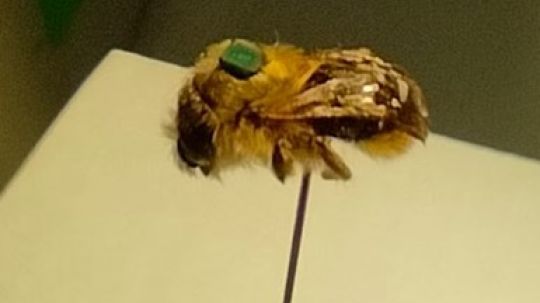The commercial production of many fruit and vegetable crops is reliant on insect pollination. The level of pollination a flower receives directly impacts on the size, firmness and shelf life of fruits and seeds. Most of this pollination is done by bees, including wild bees (solitary species, as well as social bumblebees) and managed bees, primarily honeybees and bumblebees. Using multiple pollinators can increase the value of a crop through improved levels of pollination. This project focuses on the red mason bee (RMB), Osmia bicornis, a common species of bee that occurs throughout mainland Europe and the UK. RMB do not sting and have a preference for tree pollen, which includes top fruit crops such as apples, pear and cherry. They are currently used commercially in mainland Europe (France and Germany) and are beginning to be used within the UK for supplemental pollination of fruit crops.
RMBs are small (around 10mm) solitary bees. The females build nests within cavities in walls, hollow plant stems or artificial nest tubes. If you’ve ever seen bees hovering around holes in brick walls, these are likely mason bees. The nest consists of a series of cells constructed with mud walls. The female collects pollen and deposits it into the mud cell, creating a ball of pollen. Once this is complete, an egg is laid on top of the pollen and the mud cell sealed. The female will continue to do this until there are around 8-10 individual nest cells in one nest tube. These eggs hatch and larvae consume the pollen ball over the summer, spinning a cocoon in late summer and then undergoing metamorphosis to become an adult bee which will emerge the following spring.

For commercial use, cocoons are placed in the crop in the spring, alongside a series of artificial nest tubes which are spaced throughout the crop. The filled nest tubes are collected at the end of summer and cocoons are extracted in the autumn and overwintered to be placed into an orchard the following year. The system allows larger populations of mason bees to be maintained in the crop than would otherwise be the case with no intervention, and this translates into better crop pollination in areas where there are reduced pollinator communities.
Whilst the RMB seems an ideal candidate for commercial pollination, relatively little is known about their basic biology – how their populations are structured, what diseases they get etc. This is a concern as without this understanding, the risks (disease spread and negative impacts on wild bees) of high concentrations of RMBs being artificially added to orchards cannot be understood.
This project aims to further our understanding of how individual red mason bees move around an orchard, allowing us to better place them for supplemental crop pollination. With traditional methods it is difficult to track individual bees (this mainly involves marking a bee and then trying to chase it around) and with modern camera traps the time it takes to review footage from cameras across a whole orchard make it an unfeasible project. We therefore aim to use a radio frequency identification (RFID) system to track red mason bees for the first time. The use of a RFID system involves attaching RFID chips (0.5mm squares) to the insect, this has never been done with an insect as small as a red mason bee. Specialist RFID chips that are small enough to be attached to red mason bees are very expensive and had to be shipped from Germany. Without the funding from the Eva Crane Trust, we would not have been able to undertake this work.
RFID systems were developed to cheaply track stock in warehouses. (Passive) RFID tags work through reflecting a radio signal from a reader back into the reader, readers can differentiate between different chips by the signals that they return, meaning that the data collected is the time that a chip passed within range of a reader and the specific chip code. This is considered very high-quality data for an entomologist as it is often difficult to tell the difference between individual insects of the same species. RFID chips have been used in several entomological studies, including to track paper wasps and ants.


One drawback of small RFID chips is that they can only be detected from very short distances (approx. 5cm), this means that the readers must be placed exactly where the insects will pass through to collect any data – rather than an active system where insects can be tracked as they move around an area. Due to this limitation, RFID chips have mainly been used to study social species, such as honeybees or bumblebees. Although red mason bees are a solitary bee, they share nesting locations, we can therefore place RFID readers within artificial nest tubes to record the movement of tagged bees around an area. Understanding how populations move within an orchard will allow us to better understand the potential impacts of artificially high numbers of red mason bees on wild bees and therefore better inform growers.
As RFID chips have not been used on red mason bees before, it is important to first understand if the addition of the chips affects the survival or behaviour of the red mason bees, this formed the first part of our work, without first research question being:
Do RFID chips affect survival of red mason bees
We kept RMBs in controlled laboratory conditions with some individuals chipped and some not, we then compared the activity levels (feeding, flight and mating frequency/duration) as well as the length of time the bees survived for. One of the challenges that comes with working with solitary bees is that the adults are only available during the time they’re naturally active, this means that the RFID experiments were limited to between April and July.
Following published rearing systems, we saw very short survival times of adult bees, making it impossible to compare the survival of chipped and unchipped bees. Because of this, we had to spend the beginning of the season developing a system to keep red mason bee adults alive in artificial conditions for as long as they would live in the wild. Due to the unplanned method development, we were only able to run one survival experiment which compared chipped and unchipped bees. The results from this experiment were very promising, however, this work will need to be repeated next year in order to gain enough data to reach a conclusion on the effect of the RFID chips.
Does the reader reliably record tagged bees moving through it
The next step of the project is to investigate how reliable the data generated by the RFID system is. To do this, cameras were placed opposite the RFID readers and a list of visiting times calculated from the camera were compared to the data the RFID system generated.
To maximise the data gathered, we used bumblebees as a test species to investigate the accuracy of the RFID system. We found that for the most part the RFID system produced reliable data, however there were instances where false reads were produced on a large scale, so more work needs to be done to identify why false reads occurred and how to prevent them or screen for them in initial data handling.
Conclusion
This work is still in its infancy, and while much more needs to be done, the results obtained so far are encouraging. Next year we will continue to trial the use of RFID chips on red mason bees, once again running the laboratory survival experiments as well as further modifying the RFID reader nesting tubes in hopes of making them more desirable. Once this work is complete and we have fully understood the impact of RFID chips on red mason bees, if appropriate, we will use the RFID system to track the movement of individual females around an orchard between artificial nest sites, allowing us to better understand how female red mason bees select nest sites and how best we can manipulate them to ensure maximum pollination benefit to the crop.
Fiona Tainsh, University of Warwick, UK
Ref.: ECTA_20230307
Completed: 2024

